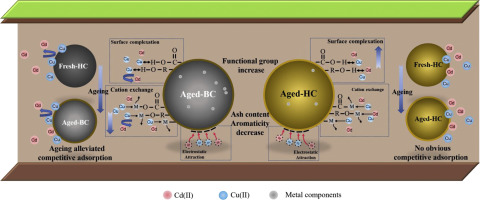当前位置:
X-MOL 学术
›
Sci. Total Environ.
›
论文详情
Our official English website, www.x-mol.net, welcomes your
feedback! (Note: you will need to create a separate account there.)
Oxidative ageing of biochar and hydrochar alleviating competitive sorption of Cd(II) and Cu(II).
Science of the Total Environment ( IF 8.2 ) Pub Date : 2020-04-04 , DOI: 10.1016/j.scitotenv.2020.138419 Yuyan Liu 1 , Lu Wang 1 , Xiaoyuan Wang 1 , Fanqi Jing 1 , Ruihai Chang 1 , Jiawei Chen 1
Science of the Total Environment ( IF 8.2 ) Pub Date : 2020-04-04 , DOI: 10.1016/j.scitotenv.2020.138419 Yuyan Liu 1 , Lu Wang 1 , Xiaoyuan Wang 1 , Fanqi Jing 1 , Ruihai Chang 1 , Jiawei Chen 1
Affiliation

|
Biochar and hydrochar have been served as attractive adsorbents for remediation of polluted water and soil, but it is lack of the long-term ageing effects on competitive adsorption of co-existing heavy metals by these carbonized materials. By this, corn stalk was used as carbon precursor to prepare biochar (500 °C) and hydrochar (200 °C). The single-metal and binary-metal Cd(II)/Cu(II) sorption were conducted on biochar and hydrochar before and after ageing using artificial accelerated ageing of 5% H2O2 treatment. The elemental analysis, BET, SEM, FTIR, XRD and Zeta potential were used to characterize the physicochemical properties of carbonized material samples. The results showed that oxidative ageing could increase O content and O-containing functional groups but decrease C content, metal content and aromaticity degree. Ageing hardly affected the SSA and crystallographic structures of biochar and hydrochar. The reduction of metal content in Aged-BC caused a decline of sorption capacity, indicating that cation exchange would be the predominant factor involved in biochar sorption for Cd(II) and Cu(II). As for hydrochar with more O-containing functional groups than biochar, the dominated sorption mechanism would be surface complexation, due to higher sorption capacity of Aged-HC with richer O-containing functional groups. In binary-metal system, the competitive sorption of Cd(II) and Cu(II) on biochar was observed obviously but that on hydrochar was limited. Ageing could increase the sorption capacity of Cd(II) in binary-metal system, resulting in alleviating competitive adsorption. The total sorption amount of Cd(II) and Cu(II) by biochar was markedly greater than that of hydrochar before or after ageing, suggesting that biochar can be still more capable than hydrochar for handling Cd(II) and Cu(II) in single-metal or binary-metal. These findings suggest us to consider the long-term effect on immobilization of co-existing heavy metals and alleviating competitive adsorption of carbonized materials as alternative amendment for contaminated sites.
中文翻译:

生物炭和水炭的氧化老化减轻了Cd(II)和Cu(II)的竞争性吸附。
生物炭和水焦炭已被用作有吸引力的吸附剂,用于污染水和土壤的修复,但是缺乏长期老化对这些碳化材料对共存重金属竞争性吸附的影响。由此,玉米秸秆被用作碳前驱物以制备生物炭(500℃)和水焦炭(200℃)。使用5%H2O2处理的人工加速老化,在老化前后对生物碳和水碳进行单金属和二金属Cd(II)/ Cu(II)吸附。元素分析,BET,SEM,FTIR,XRD和Zeta电位用于表征碳化材料样品的理化性质。结果表明,氧化时效可以提高O含量和含O官能团的含量,但降低C含量,金属含量和芳香度。老化几乎不会影响生物炭和水焦的SSA和晶体结构。Ag-BC中金属含量的减少导致吸附能力下降,这表明阳离子交换将是Cd(II)和Cu(II)生物炭吸附的主要因素。对于具有比生物炭更多的含O官能团的水碳,主要的吸附机理将是表面络合,这是由于具有更丰富的含O官能团的老年HC的更高的吸附能力。在二元金属体系中,Cd(II)和Cu(II)在生物炭上的竞争性吸附明显,但在水焦上的吸附有限。老化会增加Cd(II)在二元金属体系中的吸附能力,从而减轻竞争性吸附。在老化之前或之后,生物炭对Cd(II)和Cu(II)的总吸附量显着大于水碳,表明生物炭比水碳更能处理水中的Cd(II)和Cu(II)。单金属或二元金属。这些发现建议我们考虑对共存重金属的固定化和减轻碳化材料的竞争性吸附的长期影响,作为对污染场地的替代性修正。
更新日期:2020-04-06
中文翻译:

生物炭和水炭的氧化老化减轻了Cd(II)和Cu(II)的竞争性吸附。
生物炭和水焦炭已被用作有吸引力的吸附剂,用于污染水和土壤的修复,但是缺乏长期老化对这些碳化材料对共存重金属竞争性吸附的影响。由此,玉米秸秆被用作碳前驱物以制备生物炭(500℃)和水焦炭(200℃)。使用5%H2O2处理的人工加速老化,在老化前后对生物碳和水碳进行单金属和二金属Cd(II)/ Cu(II)吸附。元素分析,BET,SEM,FTIR,XRD和Zeta电位用于表征碳化材料样品的理化性质。结果表明,氧化时效可以提高O含量和含O官能团的含量,但降低C含量,金属含量和芳香度。老化几乎不会影响生物炭和水焦的SSA和晶体结构。Ag-BC中金属含量的减少导致吸附能力下降,这表明阳离子交换将是Cd(II)和Cu(II)生物炭吸附的主要因素。对于具有比生物炭更多的含O官能团的水碳,主要的吸附机理将是表面络合,这是由于具有更丰富的含O官能团的老年HC的更高的吸附能力。在二元金属体系中,Cd(II)和Cu(II)在生物炭上的竞争性吸附明显,但在水焦上的吸附有限。老化会增加Cd(II)在二元金属体系中的吸附能力,从而减轻竞争性吸附。在老化之前或之后,生物炭对Cd(II)和Cu(II)的总吸附量显着大于水碳,表明生物炭比水碳更能处理水中的Cd(II)和Cu(II)。单金属或二元金属。这些发现建议我们考虑对共存重金属的固定化和减轻碳化材料的竞争性吸附的长期影响,作为对污染场地的替代性修正。











































 京公网安备 11010802027423号
京公网安备 11010802027423号